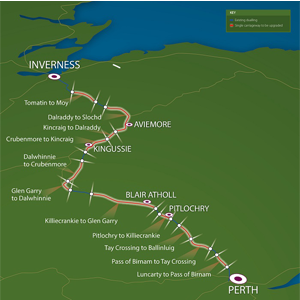A9 Dualling and Tourism

The A9 Dualling project is one of Scotland’s major infrastructure projects which is budgeted at £3bn with a planned completion date of 2025.
The Moffat Centre's role, working with Jacobs and Transport Scotland, is to lead route-based marketing and tourism development from inception.
This arterial route already enjoys significant leisure and visitor traffic however it also has real potential as a tourism catalyst. Through imaginative use of technology in interpretation and marketing it will help grow business and employment in this important sector of the Scottish economy.
It has realistic potential as a branded scenic route that will provide a further tangible legacy for the A9 Dualling project.
Outputs
Initiatives underway include:
- Feasibility of route branding and marketing linked directly to wider distribution of economic benefits of tourism in less visited rural areas
- Economic analysis of employment and value of tourism in the A9 Corridor
- Development of an action plan to deliver tourism legacy benefits of the A9 Dualling through digital technology
- Joint working between VisitScotland and Transport Scotland to derive collective benefits to the Scottish economy
- Local Community, Business group, and Destination marketing organisation consultation.
Outputs and benefits
The A9 traverses a range of significant tourism assets in the form of built and natural heritage. It connects major urban centres and provides a scenic arterial route incorporating a range of landscape types, connecting history and culture. It has enormous potential to transform the lives of people and communities in its corridor and beyond by sensitively promoting regional tourism and local products and services. The development of the route will generate a range of new business opportunities for local suppliers reducing negative impacts and emphasising sustainability from inception.
To date interpretation has been limited and route branding, now becoming increasingly evident from the USA (Route 66, Highway 1) to Ireland (Wild Atlantic Way) has not been undertaken. In developing a branded product around an existing route way and established tourism provision the environmental impact is limited and business created is more sustainable.
The A9 tourism route will incorporate the development of digital services to provide information and interpretation on the surrounding environment, communities, businesses, attractions and activities. Communicating such vital market and product information via digital means reduces environmental footprints through signage or traditional physical merchandising in fragile landscapes.
The project will also incorporate enhanced lay-by provision which in turn will highlight view points, local hospitality and tourism supply, geological sites, heritage and the Scottish Government’s Scenic Routes Initiative. Once again digital technology will provide the data and interpretation to disburse tourism expenditure impacts into the surrounding rural areas in the A9 corridor and beyond.
